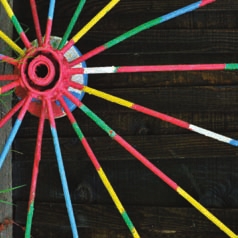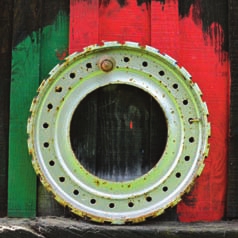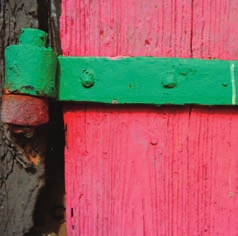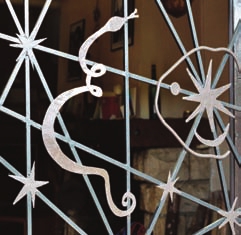A CREATION
that takes its roots
in the vibration of acoustic sound and in oneself


The creation of his instruments and his music
“I comply with the sound” J. C.
Jacky Craissac is the forerunner of a new aesthetic combining ancestral character and contemporary acoustics with genius.
His instruments, original “sound sculptures”, are designed without plan or model, only from the acoustic of natural materials, harmonics, sub-bass of metal, wood and animal skins and melodies.
“It’s the sound that brings me to the material.
It is the sound that will make it take shape.
And it’s the sound that will make me play.
I have no programming…
I’m not someone looking for… that sound or that other. I don’t know what pushes me to go towards material…
No thought, a state where energy is the only support.” J.C.
(P. 39 Jacky Craissac le silence est un son, published by Le Castor Astral, 2017 / Parcours de vie de Jacky Craissac)
His music is without transcription. It is not part of any note system belonging to the western scale.
“My music is a creation, without transcription. It is acoustic. It does not belong to any system of notes belonging to the Western scale, or at most, certain rhythmic or non-rhythmic cells and melodies. I work on the sound of the material, skins, wood, metal and their harmonics. Sounds train me constantly to express the emotional. It is a very particular state of hypersensitivity, which sometimes creates a melody.” J.C.
(P.67 Jacky Craissac le silence est un son, published by Le Castor Astral, 2017 / Jacky Craissac par Jacky Craissac)
His instruments as his music are created in the present moment.
Each concert is unique.

His school of artistic expression of oral and vibrational transmission Sound et Rythm from 1970 to 2010.
“Work with sound and rhythm is the life of the Self, which will allow the development of artistic expression, to situate oneself differently facing a family and professional environment, to cultivate a healthy lifestyle.
The individual is an art of living.” J.C.
Renowned for its pedagogical approach, he is the precursor of an ancestral pedagogy focused on the spontaneous expression which favors the present moment, emotion, expression and improvisation.
A non-academic approach that allows us to develop our hypersensitivity and our creativity.
From the 70s, Jacky Craissac set up his own school on the basis of a global conception of the individual where body, mind and soul are closely linked.
Thanks to his clairvoyance, he begins by offering courses and internships of inner rhythm because he is aware that it is necessary to develop the expression before approaching the technique and the theory.
Over the course of his experience, Jacky Craissac observes that people arrive more and more stressed:
“The bodies are stiff and heavy, listening and concentration difficult, the expression is impersonal and stereotypical.” J.C.
He perceives the necessity to do authentic artistic work that involves self-awareness.
And gradually, he develops what he called an artistic work of the human.
It is above all a matter of reconnecting with one’s own body, of reconnecting with one’s natural sensitivity too often repressed by conditioning of all kinds in order to guide everyone towards the doors of their own expression.
His creative spirit invites, thanks to many supports, to always new exercises which are as many new discoveries on the path of self-knowledge.
“No program, no goal, no level required, but the necessary time given to everyone to make their own discovery.”
Improvisation in all its forms, whether it be rhythmic, sound, physical, verbal or vocal, occupies an increasingly large place.
This conception where art is associated with work on oneself does not belong to the origins of western culture.
Jacky Craissac is aware of the natural effects of sound and rhythm on the human health and of this practice, which is part of a prevention perspective.
“All that cannot be learned. It is transmitted. The rules of sound and rhythm are to be discovered through their experience thanks to the transmission” J. C.

Many writings and aphorisms
Jacky Craissac plunges us into the heart of an original intuitive language resulting from oral transmission.
Visionary artist, he has, in his own words, “things to say” and he begins to write. Aware of living in a society where time is programmed, writing becomes a support which represents for him a gain of time within the framework of its direct oral and vibrational transmission in his school of Sound and Rhythm.
His thought, which stems from philosophy and metaphysics, is intertwined with poetry, imprinted with his heritage.
Some of his writings were published in the first book on his work Jacky Craissac le silence est un son by Le Castor Astral in September 2017.
The second part, on his teaching, will be published soon. In the collection of his conference, Jacky Craissac presents his artistic school of oral and vibrational transmission Sound and Rythm through his texts and thoughts where expression, oral transmission, the Self, sound and rhythm, dependence and independence… are keys words.
“For me, there are indeed two different schools:
– the school of knowledge which is a teaching,
– and the school of knowledge which is a transmission…
It’s the sound which makes me create.
I transmitted music ; I have not taught it...” J.C.
(p. 111 Jacky Craissac le silence est un son, éd. Le Castor Astral, 2017 / Jacky Craissac par Jacky Craissac / Une école artistique différente)

A universe of colors
Jacky Craissac lives in a universe of color, as much through sound as through his paintings and his place of life.
There appear elements of the universal symbolism that can be observed in different civilizations, for example the wheel, clear colors such as one could find them in tibetan culture.
“Colors are very important to me. I need these bright colors. It was a discovery.
I could not receive any influence from the moment I did not have a childhood in the maternal environment.
So it’s still curious. But I like to be in this moment of not knowing.
We are experiencing something, but we do not know.
So these colors, I need them.”
